“The future belongs to those who believe in the beauty of their dreams.” – Eleanor Roosevelt. This quote resonates deeply with the fashion industry, where dreams and innovation are the driving forces behind every creation. Today, technology is transforming the way the industry operates, from design to retail, and beyond.
Artificial intelligence is at the forefront of this change. It’s not just a tool; it’s a game-changer. From predicting trends to optimizing supply chains, AI is helping businesses stay ahead of the curve. For instance, more than half of fashion executives report that their companies are utilizing Generative AI, which could add up to $275 billion to the industry’s operating profits in the next few years1.
This technology is also enhancing customer experiences. Personalized recommendations and virtual try-ons are becoming the norm, making shopping more engaging and efficient. AI-driven systems are even helping to reduce waste by accurately predicting demand and optimizing material usage1.
As we delve deeper into this article, we’ll explore how artificial intelligence is reshaping the fashion industry, from design to retail, and what it means for the future of business and creativity.
Key Takeaways
- Artificial intelligence is revolutionizing the fashion industry, from design to retail operations.
- Generative AI could add up to $275 billion to the industry’s operating profits in the next few years1.
- AI enhances customer experiences through personalized recommendations and virtual try-ons.
- Predictive trend analysis helps reduce waste and optimize material usage1.
- AI-driven supply chain optimization leads to faster turnaround times and cost efficiency2.
The Evolution of AI in Fashion
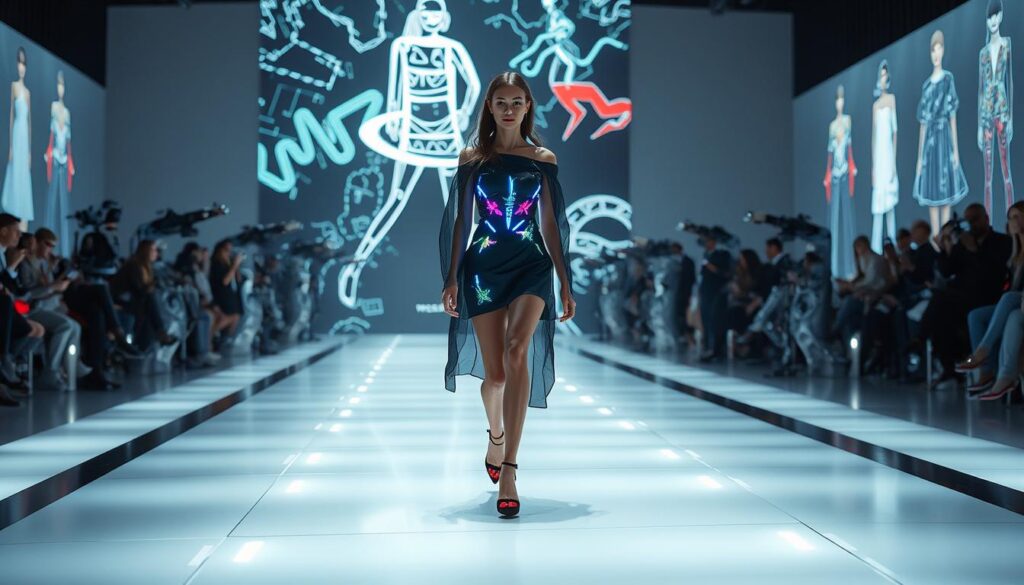
From its early stages to its current sophistication, technology has redefined the fashion landscape. What began as simple automation tools has now evolved into a cornerstone of innovation, reshaping every aspect of the industry.
Milestones in Technology Development
The journey of technology in fashion is marked by significant breakthroughs. Early advancements focused on automating repetitive tasks, but today, systems can predict trends with up to 95% accuracy, enabling retailers to optimize inventory and reduce excess stock3.
One notable milestone is the introduction of visual search tools, which have increased search accuracy by 30%, driving higher conversion rates in online retail3. Another breakthrough is the use of technology in design processes, with tools like AiDa speeding up the process by 60-70%4.
Shifting Paradigms in Traditional Fashion
Traditional practices in the fashion industry have undergone a dramatic transformation. Technology has enabled brands to offer personalized experiences, with tools like the Zegna X configurator creating over 49 billion outfit combinations for customers4.
Moreover, the integration of technology in supply chain operations has led to a potential reduction in logistics costs by 10-20%3. This shift not only enhances efficiency but also promotes sustainability by reducing waste through optimized processes3.
Legacy brands and emerging startups alike are embracing these innovations. For instance, Heuritech’s technology can now predict trends up to 24 months in advance, a significant improvement from its previous 12-month capability4.
As technology continues to evolve, it is clear that its impact on the fashion industry is profound. From design to retail, these advancements are setting new standards for creativity, efficiency, and customer satisfaction.
How AI Agents Are Influencing Fashion Design and Retail
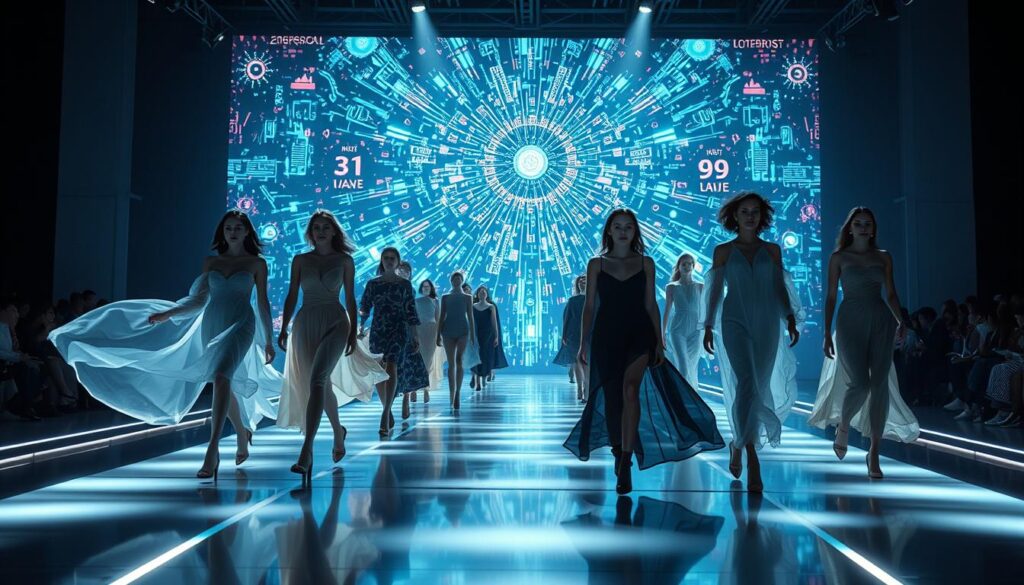
The integration of advanced technologies is reshaping the fashion landscape. From streamlining design processes to enhancing retail operations, these tools are driving efficiency and innovation across the industry. Companies are leveraging these advancements to stay competitive and meet evolving customer demands.
One of the most significant impacts is on the design process. Tools powered by modern algorithms generate design suggestions and optimize patterns, reducing iterations and saving time5. This allows designers to focus on creativity while maintaining efficiency. For example, a European fashion label uses these tools to iterate new ideas based on previous collections6.
In retail, technology is refining the shopping experience. Visual search and natural language processing enable customers to find products quickly and accurately5. Brands are also using chatbots to act as personal shoppers, enhancing interaction and satisfaction6. These innovations are making online shopping more engaging and efficient.
Inventory management has also seen significant improvements. By analyzing historical sales and demand patterns, companies can minimize excess stock and reduce out-of-stock situations5. This not only cuts costs but also ensures customers find what they need. A specialty retail chain, for instance, uses simulations to avoid stockouts and improve store performance6.
Personalization is another area where technology shines. Algorithms analyze browsing and purchase history to provide tailored recommendations, increasing the likelihood of a purchase5. This level of customization fosters customer loyalty and enhances the overall shopping experience.
As the industry continues to evolve, the role of technology in fashion will only grow. From design to retail, these tools are setting new standards for efficiency, creativity, and customer satisfaction. For more insights on how technology is transforming industries, explore this resource.
Revolutionizing Fashion Design with AI
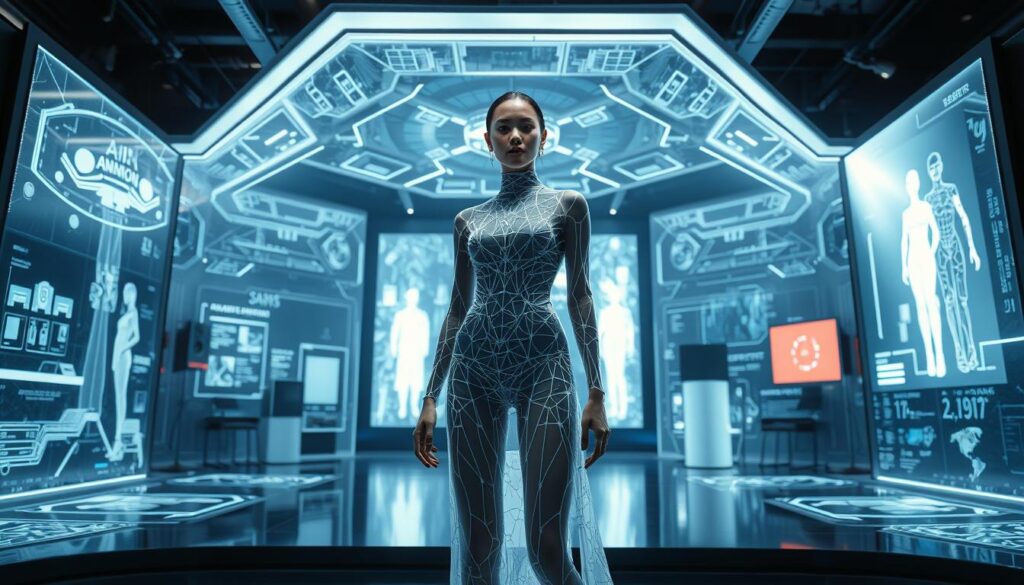
Modern tools are unlocking unprecedented creativity in the world of style. These platforms are not just assisting designers; they are redefining the entire creative process. By integrating advanced technologies, the industry is witnessing a surge in innovative approaches that were once unimaginable.
Design Innovation and Unconventional Creativity
One of the most significant contributions of these tools is in rapid prototyping. Designers can now explore multiple variations of a product in minutes, saving time and resources. For instance, collaborations like Tommy Hilfiger with IBM have showcased how these platforms generate novel concepts and virtual prototypes7.
These tools also assist in refining creative visions. By analyzing historical data and current trends, they suggest unconventional elements that align with emerging fashion trends8. This allows designers to experiment with bold ideas while staying relevant to market demands.
Visual presentation has also been transformed. Platforms provide realistic images and simulations, enabling designers to visualize their creations before production. This reduces the need for physical prototypes, minimizing material waste and costs5.
Real-world examples highlight the impact of these innovations. Brands are leveraging these tools to streamline their workflows, fostering experimental creativity. The integration of these platforms into traditional processes is setting new standards for efficiency and originality.
As the industry evolves, these technologies will continue to push the boundaries of what’s possible in design. From concept to creation, they are empowering designers to explore uncharted territories and redefine the future of style.
Enhancing Retail Operations through AI

Retail operations are undergoing a transformation, driven by advanced tools. These innovations are streamlining processes, improving efficiency, and elevating the shopping experience for customers. From in-store interactions to online journeys, technology is reshaping how retailers operate.
Streamlining In-Store Processes
In physical stores, technology is optimizing staffing and merchandising. Real-time data analysis helps retailers allocate resources effectively, ensuring customers receive prompt service. For example, Levi Strauss launched a machine learning boot camp to train employees, improving retention and operational efficiency9.
Merchandising has also seen improvements. Tools analyze customer behavior to suggest optimal product placements, boosting sales. High-end brands achieve a 60-70% conversion rate through appointment-only shopping, enhancing the luxury experience9.
Optimizing Online Customer Journeys
E-commerce platforms are leveraging technology to create seamless shopping experiences. Personalized recommendations, powered by algorithms, increase customer engagement and sales. Companies excelling at personalization report a 40% revenue boost compared to those that don’t9.
Virtual try-on features allow customers to visualize items before purchasing, reducing returns. Intuitive search functions, like visual search, make finding products effortless. These innovations are setting new standards for online retail.
Inventory management is another area benefiting from these advancements. Predictive analytics minimize overstocking and stockouts, ensuring customers find what they need. This precision reduces costs and enhances supply chain efficiency10.
Retailers are also using insights to make better sales decisions. By analyzing engagement metrics, they can forecast demand and adjust strategies accordingly. This leads to improved operational efficiency and higher customer satisfaction.
Transforming the Customer Shopping Experience
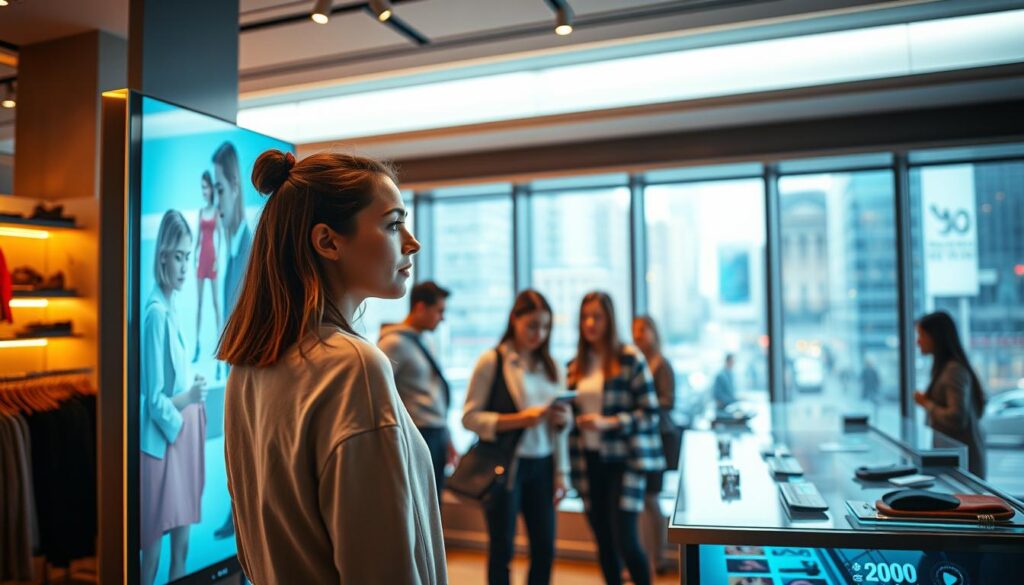
The way customers shop is evolving, thanks to advanced tools that tailor every interaction. These innovations are making shopping more personal, efficient, and enjoyable. From virtual try-ons to chatbots, technology is reshaping how consumers engage with brands.
Personalizing Consumer Interactions
Personalization is at the heart of modern shopping. Tools analyze customer preferences to offer tailored recommendations, increasing the likelihood of a purchase. For example, AI-powered product recommendations can boost sales by up to 30% by suggesting items that match individual tastes11.
Augmented reality is another game-changer. Virtual try-ons allow customers to see how products fit or look before buying. This technology has been shown to reduce return rates by up to 40%, as shoppers feel more confident in their choices12.
Chatbots are also enhancing the customer experience. They provide instant support, answering questions and guiding shoppers 24/7. Businesses using these tools report a 70% reduction in response times, improving overall satisfaction11.
Dynamic content personalization is another key feature. It adapts in real-time to user behavior, presenting relevant products and offers. This approach can increase conversion rates by 20%, making shopping more engaging11.
These innovations are not just improving the shopping experience; they’re building brand loyalty. By understanding and meeting customer needs, retailers are creating lasting relationships. As technology continues to evolve, the future of shopping looks even more personalized and seamless.
Optimizing Supply Chain and Inventory Management
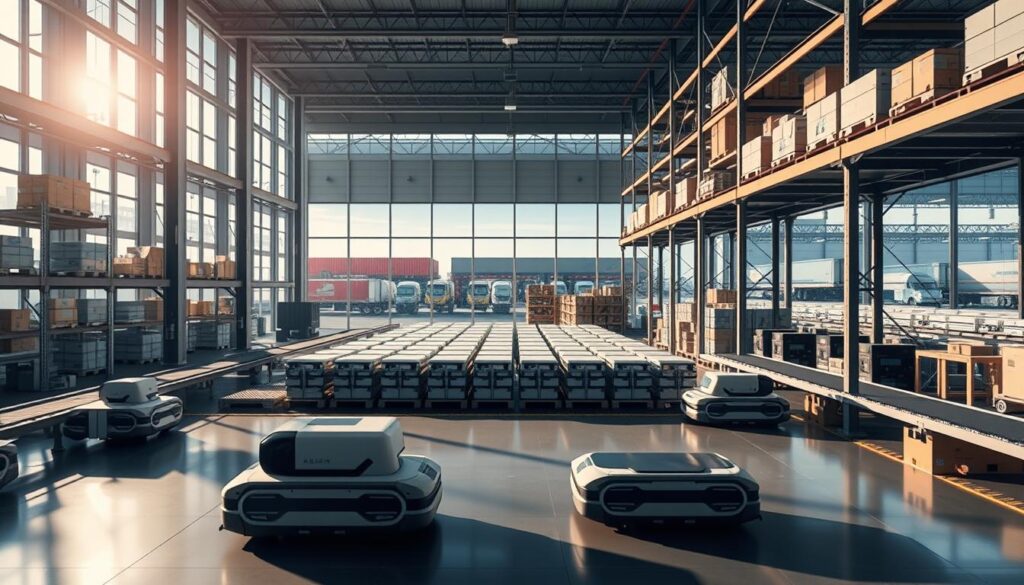
Efficiency in supply chain and inventory management is now more achievable than ever, thanks to advanced analytical tools. These technologies are transforming how businesses handle their operations, ensuring smoother workflows and better outcomes.
One of the most significant advancements is in forecasting. By analyzing historical sales, market trends, and customer behavior, these tools predict demand with remarkable accuracy. This reduces excess stock and prevents shortages, ensuring optimal product availability13.
Real-time data insights are also enhancing decision-making. Retailers can now monitor inventory levels and automatically trigger restocking orders, minimizing delays and inefficiencies14. This level of precision streamlines the entire process, from production to delivery.
Companies like Inditex-Zara have successfully integrated these technologies. Their approach reduces the ‘bullwhip effect’ and ensures lean inventory, making them highly responsive to market demands14. This not only cuts costs but also improves customer satisfaction.
By leveraging these tools, businesses can achieve significant improvements in efficiency. Waste is minimized, overstock issues are reduced, and the overall supply chain becomes more agile. As the industry evolves, these innovations will continue to set new standards for operational excellence.
Innovative Marketing and Social Media Strategies
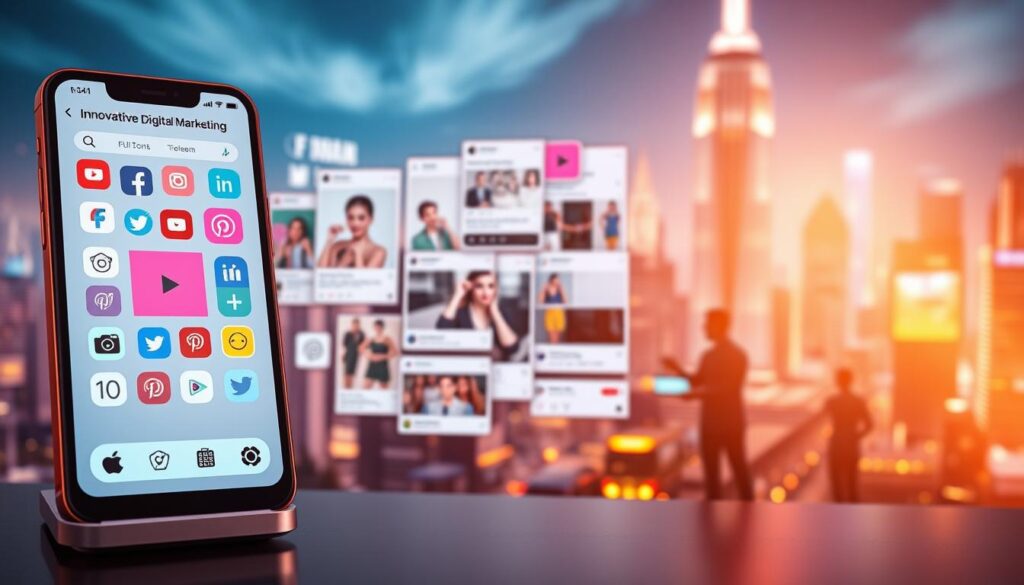
Marketing strategies are evolving rapidly with the integration of advanced tools. These innovations are reshaping how brands connect with their audiences, making campaigns more precise and impactful. From social media to email marketing, technology is driving efficiency and creativity.
One of the most significant contributions is in social media campaigns. Tools analyze trends and consumer data to create hyper-targeted advertisements. For instance, Pre Social predicts post engagement with 80% accuracy, ensuring content resonates with the audience4.
Retargeting campaigns have also seen improvements. By analyzing purchase behavior, brands can deliver personalized ads that drive conversions. This approach not only increases sales but also enhances customer loyalty9.
Email marketing is another area benefiting from these advancements. Tools automate the creation of tailored messages based on user preferences. Companies excelling at personalization report a 40% revenue boost compared to those that don’t9.
Content creation has become more efficient as well. Wair’s tool generates product titles and descriptions automatically, saving time and resources4. This allows brands to focus on strategy rather than manual tasks.
By leveraging these tools, businesses can streamline their marketing strategies and boost online engagement. The future of marketing lies in data-driven insights and personalized experiences, setting new standards for success.
Personalization and Customization in Fashion
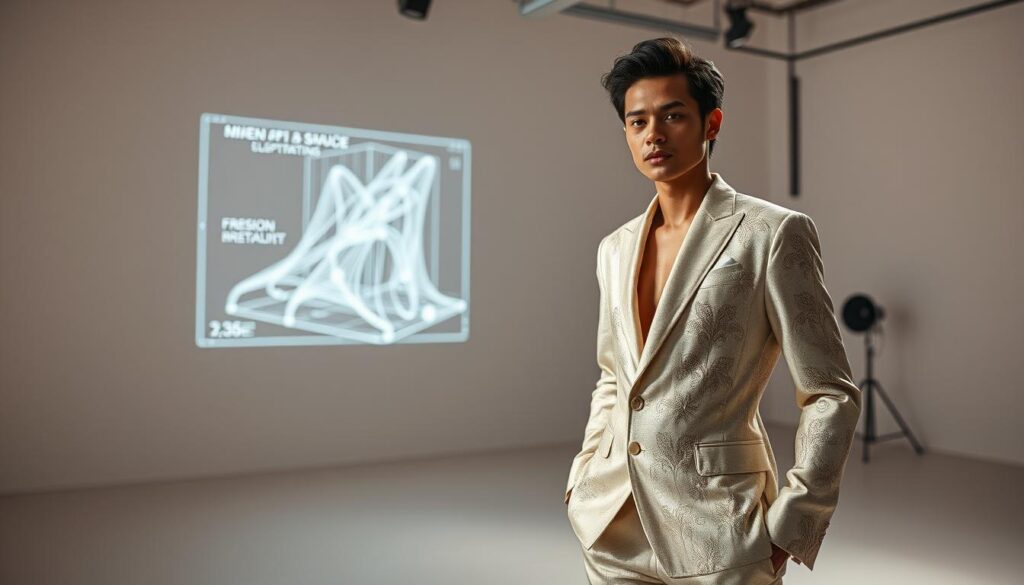
The rise of personalization is reshaping how consumers interact with fashion brands. Today, customers expect tailored experiences that reflect their unique tastes and preferences. This shift is driven by advanced tools that analyze behavioral datum to offer bespoke recommendations and custom product options15.
Platforms now leverage consumer datum to provide personalized fashion recommendations. By analyzing browsing history, purchase patterns, and even social media activity, these tools suggest items that align with individual preferences. For instance, Stitch Fix uses algorithms to curate products based on customer feedback, enhancing satisfaction and loyalty9.
Customization options have also expanded. From tailored design choices to bespoke product configurations, brands are offering unique experiences. This level of personalization not only increases engagement but also fosters long-term loyalty. Companies excelling at personalization generate 40% more revenue compared to those that don’t15.
Data-driven personalization has led to improved customer experiences and sales performance. For example, high-end brands achieve a 60-70% conversion rate through appointment-only shopping, creating a luxury experience that feels exclusive9. This approach ensures that every interaction feels uniquely tailored to the consumer.
Adapting to rapid shifts in fashion trends is another benefit. By continuously analyzing datum, brands can stay ahead of trends and meet evolving preferences. This agility is crucial in a competitive market where customer expectations are constantly changing16.
For more insights on how technology is transforming the industry, explore this resource.
Sustainable Practices Driven by AI

Sustainability is becoming a cornerstone of modern fashion, driven by innovative tools. These advancements are helping brands reduce their environmental impact while maintaining efficiency. From material selection to waste reduction, technology is reshaping how the industry approaches eco-friendly practices.
One of the key contributions is in selecting sustainable materials. Tools analyze data to identify eco-friendly options, ensuring that every item aligns with green standards. For example, brands like Stella McCartney use analytics to monitor production processes and minimize fabric waste17.
Waste reduction is another significant benefit. By optimizing manufacturing techniques, companies can minimize excess inventory and reduce material usage. This not only supports sustainability but also lowers costs, making it a win-win for businesses and the environment9.
Balancing efficiency with environmental goals is now achievable. Brands are leveraging these tools to streamline operations while meeting sustainability targets. For instance, predictive analytics help forecast demand, ensuring that production aligns with actual needs17.
Data shows that waste reduction through technology can lead to significant cost savings. By minimizing excess stock and optimizing resource usage, companies can improve their bottom line while contributing to a greener future18.
The strategic importance of sustainability in fashion cannot be overstated. As consumers demand more eco-friendly options, technology is enabling brands to meet these expectations effectively. This shift is not just about reducing waste; it’s about creating a more responsible industry for future generations.
Implementing AI Technologies in Fashion
Adopting advanced tools is reshaping how fashion businesses operate. Integrating these systems into existing workflows requires careful planning and execution. Companies must establish robust management frameworks to ensure smooth adoption and maximize benefits19.
Step-by-Step Integration Guide
The first step is to assess current processes and identify areas where technology can add value. Tools like Midjourney and DALL-E can generate innovative design concepts, reducing the need for labor-intensive iterations19. This approach saves time and resources while enhancing creativity.
Next, companies should partner with tech experts to customize solutions. For example, Levi Strauss launched a machine learning boot camp to upskill employees, improving retention and operational efficiency9. Such collaborations ensure that the system aligns with business goals.
Aligning Culture and Capabilities
Successful integration also depends on aligning company culture with technical capabilities. Training programs and workshops can help employees adapt to new processes. High-end brands achieve a 60-70% conversion rate through appointment-only shopping, showcasing the importance of tailored strategies9.
Additionally, robust frameworks are essential for managing these systems. Predictive analytics, for instance, can optimize inventory and reduce waste, ensuring smoother operations19.
Real-World Examples
Brands like Stitch Fix have successfully integrated tools like GPT-3 and DALL-E 2 to enhance customer satisfaction. These technologies analyze vast datasets to provide personalized recommendations, boosting sales by up to 40%9.
By leveraging these insights, businesses can create innovative retail spaces that stand out in a competitive market. The result is improved operational efficiency and enhanced customer engagement19.
Seamless integration of technology not only streamlines processes but also drives long-term success. Companies that embrace these systems are better positioned to meet evolving demands and stay ahead in the industry.
Emerging Trends and Future Outlook in AI Fashion
The future of the fashion industry is being shaped by cutting-edge technologies. These innovations are not just transforming current practices but are also setting the stage for what’s to come. From advanced forecasting to immersive experiences, the industry is on the brink of a major evolution.
One of the most significant trends is the use of predictive analytics. By analyzing historical data, these tools can forecast future styles with remarkable accuracy. This allows brands to stay ahead of consumer demands and reduce waste20.
Virtual reality is another game-changer. It enhances the shopping experience by allowing customers to visualize products before purchase. This technology has been shown to reduce return rates by up to 40%, making it a win-win for both consumers and retailers20.
Machine learning is also playing a pivotal role. By analyzing vast datasets, including social media activity, these systems provide valuable insights into consumer behavior. This helps brands create personalized experiences that drive engagement and loyalty20.
Generative models are pushing the boundaries of creativity. These tools enable designers to experiment with new aesthetics and produce innovative designs quickly. This not only speeds up the design process but also fosters a culture of experimentation21.
The integration of these technologies is expected to grow significantly. Studies predict that the use of advanced tools will lead to more sustainable practices and faster time-to-market20. This shift will help brands meet the increasing demand for eco-friendly and ethically produced products.
As the industry evolves, continuous adaptation will be key. Brands must invest in research and development to stay competitive. Those who embrace these innovations will be better positioned to thrive in an ever-changing market.
The future of fashion is not just about technology; it’s about creating meaningful connections with consumers. By leveraging these tools, brands can deliver personalized, sustainable, and innovative experiences that resonate with their audience.
Conclusion
The fashion industry is undergoing a profound transformation, driven by intelligent technologies. These innovations are reshaping every aspect, from design to retail operations. Improved customer experience, streamlined processes, and enhanced creativity are just a few of the benefits22.
Smart decision-making and strategic implementation of these tools can drive business success. Brands that adapt quickly will stay ahead in a competitive market. The future reality of this technology promises to redefine industry standards23.
Industry professionals must embrace these changes. By leveraging data-driven insights, they can create meaningful connections with customers. The way forward is clear: adapt, innovate, and thrive in this new era of intelligence.
FAQ
How is technology transforming the fashion industry?
What role does artificial intelligence play in fashion design?
How do retailers use AI to improve the shopping experience?
Can AI help reduce waste in the fashion supply chain?
What are the benefits of AI in trend forecasting?
How does AI enhance customer personalization in fashion?
What challenges do brands face when implementing AI?
How is augmented reality changing the way people shop for fashion?
What impact does AI have on sustainability in fashion?
How can small businesses leverage AI in fashion?
Source Links
- Generative AI in Fashion – Beyond Creative Roadblocks
- The Fashion Industry Is Getting More Intelligent With AI
- The Revolution Unveiled: How AI is Reshaping the Fashion Industry
- From design, supply, distribution, marketing to retail: How AI is being used in the fashion industry
- AI in fashion: Use cases, benefits, implementation and technologies
- How AI Is Reshaping the Fashion Industry
- Weaving Elegance With Intelligence: How Luxury Brands Are Embracing AI
- Revolutionizing Fashion Industry with Generative AI | inoday
- Generative AI: Unlocking the future of fashion
- Artificial Intelligence in Retail: Fashion
- AI in E-Commerce: Personalized Shopping Experiences
- Revolutionizing Online Shopping with AI-Enabled Virtual Try-Ons
- How AI Can Optimize Supply Chain in Retail
- Supply chain management in the fashion retail industry: a multi-method approach for the optimisation of performances
- The value of getting personalization right—or wrong—is multiplying
- AI in Fashion Industry: Transforming Style and Retail
- AI at the Helm of Transformation: How Artificial Intelligence is Reshaping Market Power & Revolutionizing Business Dynamics
- Cyber Couture Chronicles: AI Unplugged in the World of Fashion Innovation – Indian Retailer
- AI-Assisted Creativity: Transforming Retail Store Design with Generative AI
- AI Transforming Fashion: Trends & Forecast Analysis | Newo
- Retail AI Trends Outlook for 2025 – The Robin Report
- Role of AI in Retail – GeeksforGeeks
- 8 Applications of AI in Fashion | Analytics Steps







